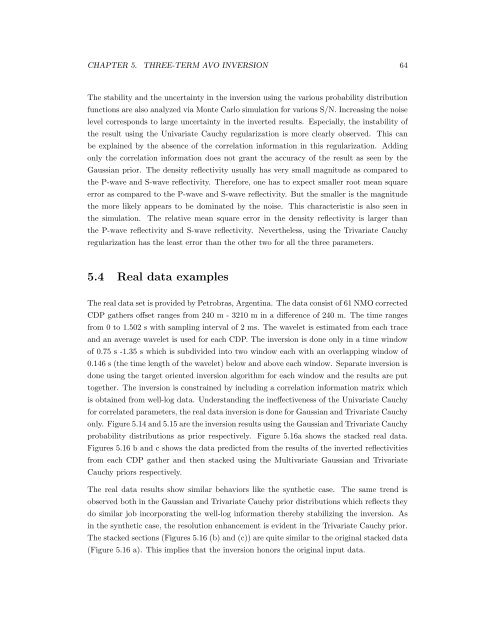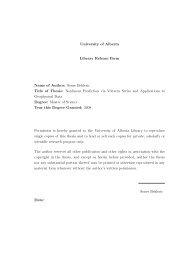Regularization of the AVO inverse problem by means of a ...
Regularization of the AVO inverse problem by means of a ...
Regularization of the AVO inverse problem by means of a ...
You also want an ePaper? Increase the reach of your titles
YUMPU automatically turns print PDFs into web optimized ePapers that Google loves.
CHAPTER 5. THREE-TERM <strong>AVO</strong> INVERSION 64<br />
The stability and <strong>the</strong> uncertainty in <strong>the</strong> inversion using <strong>the</strong> various probability distribution<br />
functions are also analyzed via Monte Carlo simulation for various S/N. Increasing <strong>the</strong> noise<br />
level corresponds to large uncertainty in <strong>the</strong> inverted results. Especially, <strong>the</strong> instability <strong>of</strong><br />
<strong>the</strong> result using <strong>the</strong> Univariate Cauchy regularization is more clearly observed. This can<br />
be explained <strong>by</strong> <strong>the</strong> absence <strong>of</strong> <strong>the</strong> correlation information in this regularization. Adding<br />
only <strong>the</strong> correlation information does not grant <strong>the</strong> accuracy <strong>of</strong> <strong>the</strong> result as seen <strong>by</strong> <strong>the</strong><br />
Gaussian prior. The density reflectivity usually has very small magnitude as compared to<br />
<strong>the</strong> P-wave and S-wave reflectivity. Therefore, one has to expect smaller root mean square<br />
error as compared to <strong>the</strong> P-wave and S-wave reflectivity. But <strong>the</strong> smaller is <strong>the</strong> magnitude<br />
<strong>the</strong> more likely appears to be dominated <strong>by</strong> <strong>the</strong> noise. This characteristic is also seen in<br />
<strong>the</strong> simulation. The relative mean square error in <strong>the</strong> density reflectivity is larger than<br />
<strong>the</strong> P-wave reflectivity and S-wave reflectivity. Never<strong>the</strong>less, using <strong>the</strong> Trivariate Cauchy<br />
regularization has <strong>the</strong> least error than <strong>the</strong> o<strong>the</strong>r two for all <strong>the</strong> three parameters.<br />
5.4 Real data examples<br />
The real data set is provided <strong>by</strong> Petrobras, Argentina. The data consist <strong>of</strong> 61 NMO corrected<br />
CDP ga<strong>the</strong>rs <strong>of</strong>fset ranges from 240 m - 3210 m in a difference <strong>of</strong> 240 m. The time ranges<br />
from 0 to 1.502 s with sampling interval <strong>of</strong> 2 ms. The wavelet is estimated from each trace<br />
and an average wavelet is used for each CDP. The inversion is done only in a time window<br />
<strong>of</strong> 0.75 s -1.35 s which is subdivided into two window each with an overlapping window <strong>of</strong><br />
0.146 s (<strong>the</strong> time length <strong>of</strong> <strong>the</strong> wavelet) below and above each window. Separate inversion is<br />
done using <strong>the</strong> target oriented inversion algorithm for each window and <strong>the</strong> results are put<br />
toge<strong>the</strong>r. The inversion is constrained <strong>by</strong> including a correlation information matrix which<br />
is obtained from well-log data. Understanding <strong>the</strong> ineffectiveness <strong>of</strong> <strong>the</strong> Univariate Cauchy<br />
for correlated parameters, <strong>the</strong> real data inversion is done for Gaussian and Trivariate Cauchy<br />
only. Figure 5.14 and 5.15 are <strong>the</strong> inversion results using <strong>the</strong> Gaussian and Trivariate Cauchy<br />
probability distributions as prior respectively. Figure 5.16a shows <strong>the</strong> stacked real data.<br />
Figures 5.16 b and c shows <strong>the</strong> data predicted from <strong>the</strong> results <strong>of</strong> <strong>the</strong> inverted reflectivities<br />
from each CDP ga<strong>the</strong>r and <strong>the</strong>n stacked using <strong>the</strong> Multivariate Gaussian and Trivariate<br />
Cauchy priors respectively.<br />
The real data results show similar behaviors like <strong>the</strong> syn<strong>the</strong>tic case. The same trend is<br />
observed both in <strong>the</strong> Gaussian and Trivariate Cauchy prior distributions which reflects <strong>the</strong>y<br />
do similar job incorporating <strong>the</strong> well-log information <strong>the</strong>re<strong>by</strong> stabilizing <strong>the</strong> inversion. As<br />
in <strong>the</strong> syn<strong>the</strong>tic case, <strong>the</strong> resolution enhancement is evident in <strong>the</strong> Trivariate Cauchy prior.<br />
The stacked sections (Figures 5.16 (b) and (c)) are quite similar to <strong>the</strong> original stacked data<br />
(Figure 5.16 a). This implies that <strong>the</strong> inversion honors <strong>the</strong> original input data.









